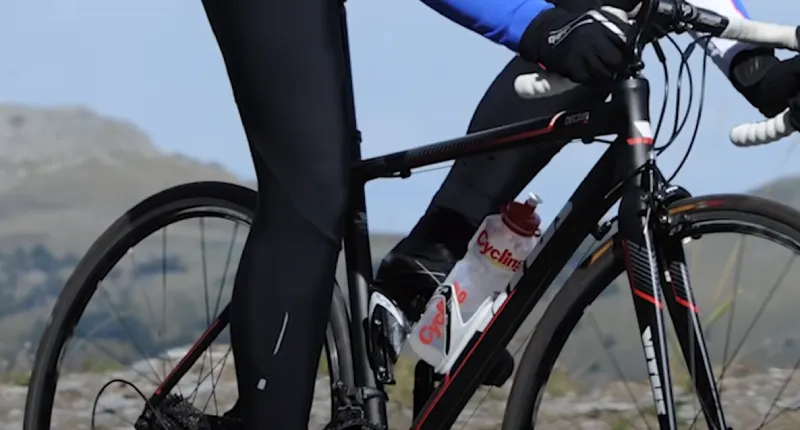Cycling exercise can help you shed excess fat from your legs. Exercises like this are excellent ways to increase your heart health, strengthen your legs, and burn calories without causing too much joint damage.
Cycling regularly can make your legs thinner, stronger, and more defined. The activity helps to reduce fat mass in your legs and shape your leg muscles. Like any aerobic activity, cycling can enhance your leg muscles.
In this blog post, we will discuss whether cycling makes your legs Skinnier and The Factors of Cycling on Leg Muscles.
Does Cycling Make Your Legs Skinnier? 5 Key Factors

With cycling and the body, most people wonder if it results in skinnier legs. Here are the factors that determine how cycling affects leg size and provide tips on maximizing leg slimming results.
The Role of Calorie Burn in Leg Slimming
Calorie burn is the key to leg slimming. Excess fat stored in your legs can be shed through high-intensity cycling. Cycling burns calories and slims legs:
- Cycling increases your heart rate, which burns fat for energy.
- Cycling burns calories, which results in reduced leg fat loss.
- Leg fat is more effectively lost with higher-intensity cycling and longer cycling sessions.
- Regular cycling sessions make your legs slimmer.
The Muscle Myth: Cardio and Resistance Training
One of the biggest misconceptions about cycling is that it results in bulky legs. Cycling promotes the development of skinny muscle mass, making your legs appear toned and defined. Cycling is a great way to cultivate skinny legs:
- The benefits of cycling include skinny muscle mass without excessive bulk.
- Cycling refines muscle without adding bulk, unlike resistance training.
- When you cycle, you need a balanced diet with skinny protein sources like chicken, fish, and legumes.
Genetic Factors and Leg Slimming
Cycling is an excellent way to slim down your legs. Cycling doesn’t directly affect the increased leg size; genetics can also determine leg size and shape. Genetics and cycling for leg shaping:
- Cycling can affect the size and shape of your legs based on your genetics. A cyclist’s thigh muscle cross-section is larger than a non-cyclist’s.
- Genetic factors beyond our control often lead to cyclists with naturally skinny or thick legs.
- Focus on how cycling enhances your fitness and takes advantage of your natural leg shape.
How Body Types Respond to Cycling
For optimal leg slimming, you can tailor your cycling routine to your unique physique by analyzing cycling’s impact on different body types. The effects of cycling on ectomorphs, endomorphs, and mesomorphs are shown below.
Ectomorphs
Naturally slim and long-limbed, Ectomorphs can benefit from cycling’s endurance-building capabilities without gaining weight. Cycling routines can be customized:
- Build endurance by riding at a moderate intensity and for a more extended period.
- Cross-train by swimming or running to avoid plateaus.
- Increasing flexibility and reducing injury risk can be achieved through yoga or pilates.
Endomorphs
Endomorphs have a naturally softer and curvier physique, with wider waists and hips and larger bones, regardless of weight. They are most important in the hips, thighs, and lower abdomen. Endomorphs commonly exhibit higher body fat and muscle characteristics, often experiencing rapid weight gain. You can customize your cycling routine by following these tips:
- For effective weight loss, combine cycling with calorie-controlled eating.
- Strengthen and define your muscles with resistance training.
- To achieve balanced fitness, cross-train different muscle groups.
Mesomorphs
Mesomorph body types are defined by their muscular and moderate frame. A mesomorph should lose or gain weight with little to no effort, as they have a low body fat level. Cycling can enhance leg strength and maintain skinniness for muscular mesomorphs. To tailor your cycling routine, follow these steps:
- Improve cardiovascular fitness and challenge muscle groups with high-intensity interval training (HIIT).
- Add resistance to your workout to strengthen and define your muscles.
- Keep your body fit by incorporating cross-training activities.
The Perfect Pedal Push for skinny legs

Cycling skills that target leg-slimming can be mastered by using proper form and maintaining a smooth and consistent pedal stroke. Cycling is an excellent way to tone your legs. As they play a massive role in pedaling, the hamstrings and quadriceps are two of the most targeted muscles during a cycling workout. To achieve a more toned and skinny leg, follow these tips:
The Role of Cadence and Resistance in Muscle Toning
Pedaling speed (cadence) and resistance are essential to muscle toning and leg slimming.
- Increasing your cadence will increase your heart rate and burn more calories.
- Strengthen and define your muscles by adding resistance to your pedals.
- You can alternate high-intensity bursts with recovery periods by using HIIT techniques.
Leg slimming with Interval Training and Hill Sprints
You can boost your leg-slimming results by doing interval training and hill sprints. Adding them to your cycling routine is as simple as:
- Alternate between high-intensity bursts and recovery periods to strengthen your muscles.
- Intensify your workout by tackling hills.
- Continually improve routines by monitoring progress.
Is It Wrong for Cyclists to Have Skinnier Legs?
Leg size is only sometimes a direct indicator of leg strength since genetics, training, and muscle composition play a role. Cyclists with skinny legs can have mighty leg muscles.
Conclusion
While cycling may not be the first thing that comes to mind when you think of leg slimming, it can be a highly effective method. With patience and consistency, cycling can help you achieve the skinny and toned legs you’ve always wanted.
The key is customizing your cycling routine based on your genetics and body type. Remember to embrace cycling as part of a balanced approach to a healthier lifestyle and incorporate other forms of exercise to achieve overall health and fitness. So, go ahead, hop on that bike, and ride your way to skinnier legs.
FAQs
Is It Wrong for Cyclists to Have Skinnier Legs?
Leg size is only sometimes a direct indicator of leg strength since genetics, training, and muscle composition play a role. Cyclists with skinny legs can have mighty leg muscles.
Does Air Cycling Tone Legs?
Performing leg cycling in the air mimics pedaling a bicycle while lying down with legs elevated. This enjoyable exercise strengthens and tones your leg muscles and is a targeted workout regimen for your lower body.
Does Cycling Make Your Legs Bigger?
It won’t make your legs bigger. Cycling tones legs but doesn’t bulk them up. Professional cyclists have muscular thighs because of varied training routines. To have strong, toned legs, maintain proper strength, weight, and endurance training.


